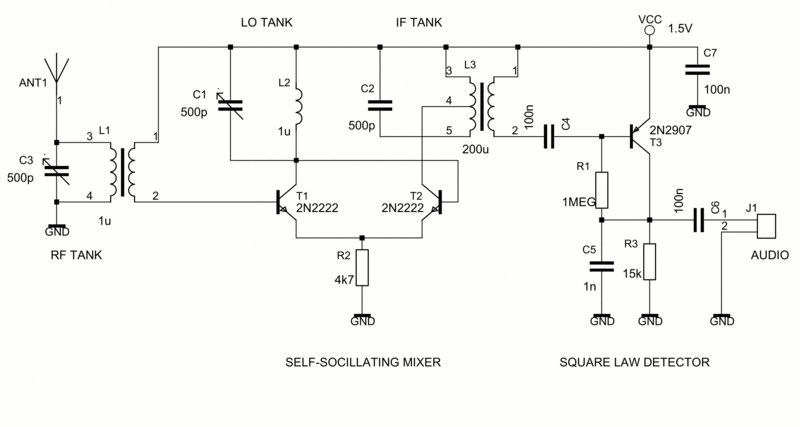This is a recovered file. The images in this post may be out of order, and there may be duplicates.
Low-power BJT converter stage for superhet
by qrp-gaijin » Wed May 13, 2015
I'm working on another low-voltage, low-power superhet design and, after a few evenings of messing around on the breadboard, have the RF converter working. Previously I had done some experiments with a single-transistor autodyne converter, but that was too hard to get working reliably, so this time I'm splitting the oscillator and mixer:
These images are out of order, from the original post





I hooked up the IF output port on the IF transformer to my FT-817's antenna input, tuned my FT817 to the IF of 2 MHz, and was able to tune in several shortwave stations with good audibility, so it's working so far.
Q1 and Q2 form a differential pair oscillator. Q3 is the mixer transistor and I connect its emitter directly to the emitters of the oscillator transistors. I have no clear idea about the implications of doing this, but the oscillator didn't stop and the mixer is working. A previous attempt used a 100 ohm resistor in the Q3 emitter and AC-coupled the oscillator emitters and the mixer emitter with 100 nF, but this stopped the oscillator from oscillating so I went for the direct-coupled approach.
Initially I connected the positive end of R2 (controlling Q3 mixer base bias) not to Vcc but instead to a 10k pot wired as a voltage divider. However I found that the mixer worked best when the voltage divider was set to maximum voltage. So I eliminated the pot and just tied R2 directly to Vcc.
RF input, from a remotely-tuned varactor-tuned loop antenna, goes into C2. I'm noticing some hand capacitance such that when I grab the control cable of the loop antenna (supplying DC voltage to the varactor), the LO is pulling slightly. This is quite strange because the varactor control cable is galvanically isolated from rest of the receiver circuit, so there's only slight capacitive coupling between the varactor control cable and the coaxial cable connecting the antenna's smaller pick-up loop to the converter. But this slight capacitive coupling is apparently enough to pull the LO.
I might try adding an isolating buffer stage between the LO and the mixer, but if I do it will be untuned. I don't want to increase the complexity of the converter by adding additional tuned circuits that have to be aligned and/or tracked. The goal is to keep the converter as simple as possible.
At some point I'm going to try varactor tuning of the LO. This will likely require increasing R1 to reduce the oscillation amplitude and prevent the oscillator waveform from detuning the varactor. Whether this smaller oscillation amplitude will be enough to drive the mixer remains to be seen.
Once the converter is working "well enough" I will attempt to add a crystal-controlled regenerative detector as the IF stage. I already have the 1.2-volt crystal-controlled regenerative detector working on a separate breadboard, but it will be tricky interfacing signals into/out of this detector.
Any comments or suggestions on the converter stage would be welcome.